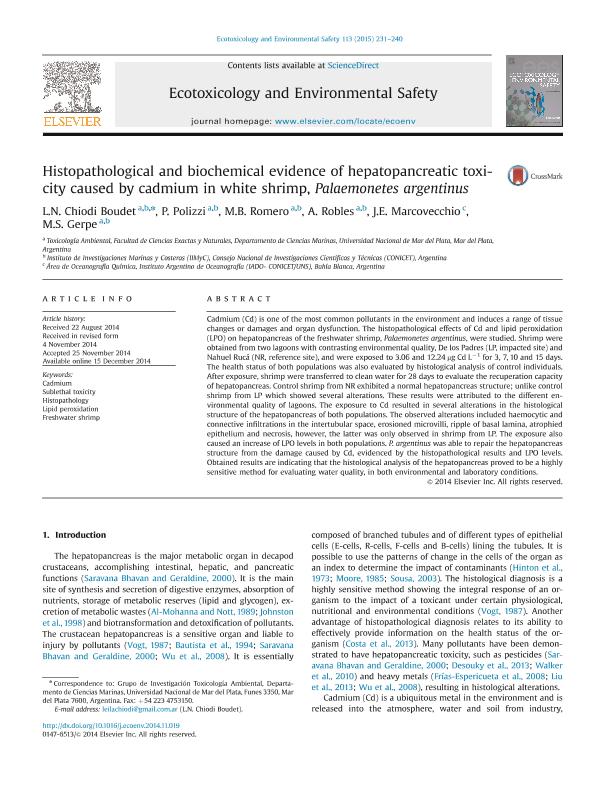Mostrar el registro sencillo del ítem
dc.contributor.author
Chiodi Boudet, Leila Natalia

dc.contributor.author
Polizzi, Paula Sabrina

dc.contributor.author
Romero, María Belén

dc.contributor.author
Robles, Alicia Daniela

dc.contributor.author
Marcovecchio, Jorge Eduardo

dc.contributor.author
Gerpe, Marcela Silvia

dc.date.available
2017-02-03T21:49:15Z
dc.date.issued
2015-03
dc.identifier.citation
Chiodi Boudet, Leila Natalia; Polizzi, Paula Sabrina; Romero, María Belén; Robles, Alicia Daniela; Marcovecchio, Jorge Eduardo; et al.; Histopathological biochemical evidence of hepatopancreatic toxicity caused by cadmium in white shrimp, Palaemonetes argentinus.; Elsevier Inc; Ecotoxicology and Environmental Safety; 113; 3-2015; 231-240
dc.identifier.issn
0147-6513
dc.identifier.uri
http://hdl.handle.net/11336/12524
dc.description.abstract
Cadmium (Cd) is one of the most common pollutants in the environment and induces a range of tissue changes or damages and organ dysfunction. The histopathological effects of Cd and lipid peroxidation (LPO) on hepatopancreas of the freshwater shrimp, Palaemonetes argentinus, were studied. Shrimp were obtained from two lagoons with contrasting environmental quality, De los Padres (LP, impacted site) and Nahuel Rucá (NR, reference site), and were exposed to 3.06 and 12.24 µg Cd L−1 for 3, 7, 10 and 15 days. The health status of both populations was also evaluated by histological analysis of control individuals. After exposure, shrimp were transferred to clean water for 28 days to evaluate the recuperation capacity of hepatopancreas. Control shrimp from NR exhibited a normal hepatopancreas structure; unlike control shrimp from LP which showed several alterations. These results were attributed to the different environmental quality of lagoons. The exposure to Cd resulted in several alterations in the histological structure of the hepatopancreas of both populations. The observed alterations included haemocytic and connective infiltrations in the intertubular space, erosioned microvilli, ripple of basal lamina, atrophied epithelium and necrosis, however, the latter was only observed in shrimp from LP. The exposure also caused an increase of LPO levels in both populations. P. argentinus was able to repair the hepatopancreas structure from the damage caused by Cd, evidenced by the histopathological results and LPO levels. Obtained results are indicating that the histological analysis of the hepatopancreas proved to be a highly sensitive method for evaluating water quality, in both environmental and laboratory conditions.
dc.format
application/pdf
dc.language.iso
eng
dc.publisher
Elsevier Inc

dc.rights
info:eu-repo/semantics/openAccess
dc.rights.uri
https://creativecommons.org/licenses/by-nc-nd/2.5/ar/
dc.subject
Cadmium
dc.subject
Sublethal Toxicity
dc.subject
Histopathology
dc.subject
Lipid Peroxidation
dc.subject
Freshwater Shrimp
dc.subject.classification
Geociencias multidisciplinaria

dc.subject.classification
Ciencias de la Tierra y relacionadas con el Medio Ambiente

dc.subject.classification
CIENCIAS NATURALES Y EXACTAS

dc.title
Histopathological biochemical evidence of hepatopancreatic toxicity caused by cadmium in white shrimp, Palaemonetes argentinus.
dc.type
info:eu-repo/semantics/article
dc.type
info:ar-repo/semantics/artículo
dc.type
info:eu-repo/semantics/publishedVersion
dc.date.updated
2017-02-03T17:51:52Z
dc.journal.volume
113
dc.journal.pagination
231-240
dc.journal.pais
Países Bajos

dc.journal.ciudad
Amsterdam
dc.description.fil
Fil: Chiodi Boudet, Leila Natalia. Universidad Nacional de Mar del Plata. Facultad de Ciencias Exactas y Naturales. Departamento de Ciencias Marinas; Argentina. Consejo Nacional de Investigaciones Científicas y Técnicas. Centro Científico Tecnológico Mar del Plata. Instituto de Investigaciones Marinas y Costeras; Argentina
dc.description.fil
Fil: Polizzi, Paula Sabrina. Universidad Nacional de Mar del Plata. Facultad de Ciencias Exactas y Naturales. Departamento de Ciencias Marinas; Argentina. Consejo Nacional de Investigaciones Científicas y Técnicas. Centro Científico Tecnológico Mar del Plata. Instituto de Investigaciones Marinas y Costeras; Argentina
dc.description.fil
Fil: Romero, María Belén. Universidad Nacional de Mar del Plata. Facultad de Ciencias Exactas y Naturales. Departamento de Ciencias Marinas; Argentina. Consejo Nacional de Investigaciones Científicas y Técnicas. Centro Científico Tecnológico Mar del Plata. Instituto de Investigaciones Marinas y Costeras; Argentina
dc.description.fil
Fil: Robles, Alicia Daniela. Universidad Nacional de Mar del Plata. Facultad de Ciencias Exactas y Naturales. Departamento de Ciencias Marinas; Argentina. Consejo Nacional de Investigaciones Científicas y Técnicas. Centro Científico Tecnológico Mar del Plata. Instituto de Investigaciones Marinas y Costeras; Argentina
dc.description.fil
Fil: Marcovecchio, Jorge Eduardo. Consejo Nacional de Investigaciones Científicas y Técnicas. Centro Científico Tecnológico Bahía Blanca. Instituto Argentino de Oceanografía (i); Argentina
dc.description.fil
Fil: Gerpe, Marcela Silvia. Universidad Nacional de Mar del Plata. Facultad de Ciencias Exactas y Naturales. Departamento de Ciencias Marinas; Argentina. Consejo Nacional de Investigaciones Científicas y Técnicas. Centro Científico Tecnológico Mar del Plata. Instituto de Investigaciones Marinas y Costeras; Argentina
dc.journal.title
Ecotoxicology and Environmental Safety

dc.relation.alternativeid
info:eu-repo/semantics/altIdentifier/url/http://www.sciencedirect.com/science/article/pii/S0147651314005314
dc.relation.alternativeid
info:eu-repo/semantics/altIdentifier/url/http://dx.doi.org/10.1016/j.ecoenv.2014.11.019
Archivos asociados
